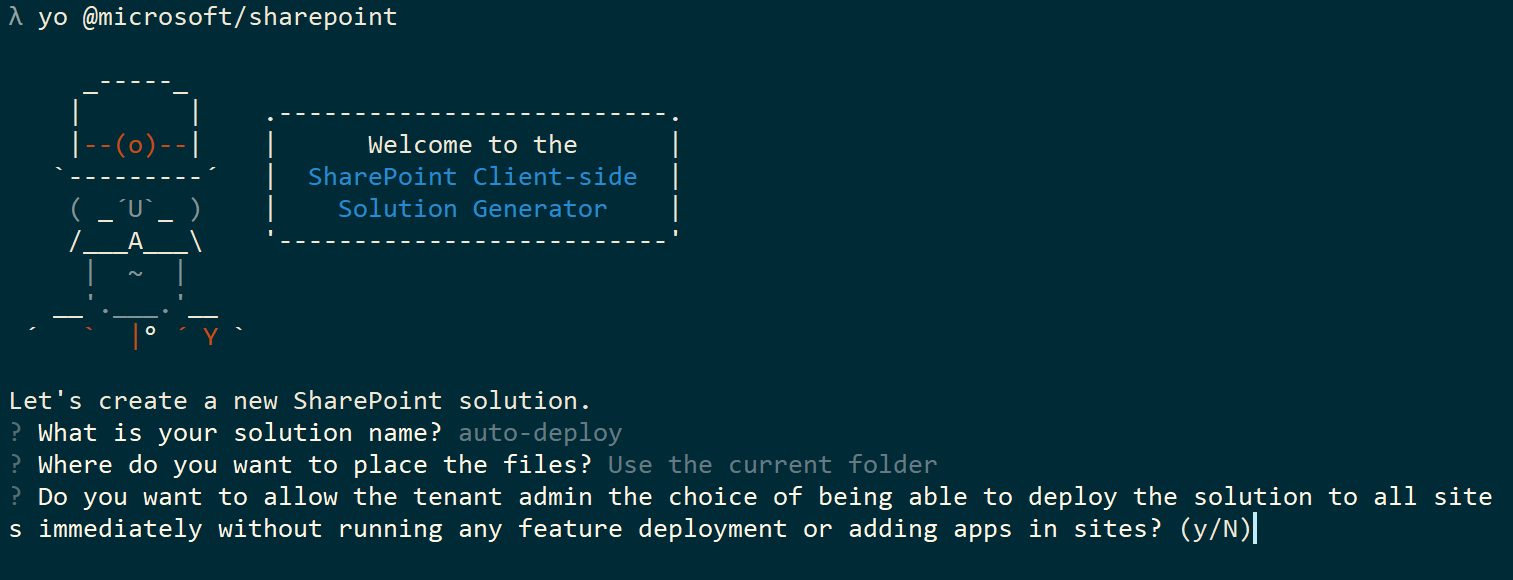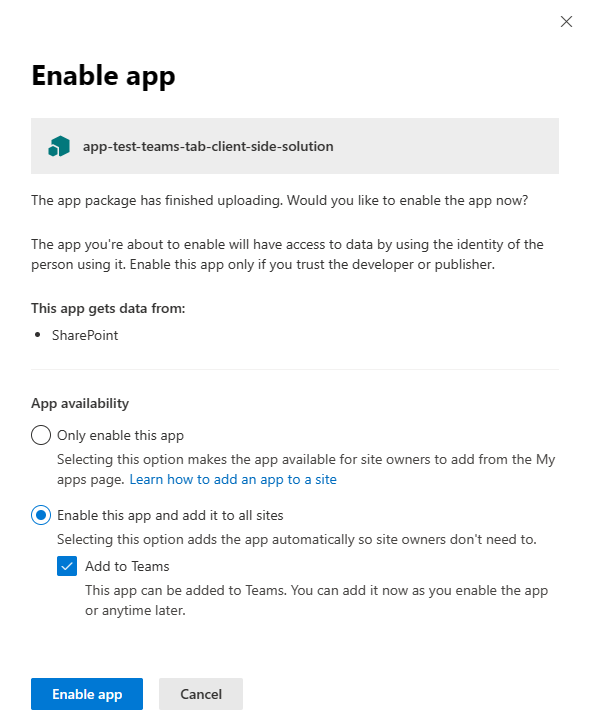Tenant-scoped solution deployment for SharePoint Framework solutions
You can configure your SharePoint Framework (SPFx) components to be immediately available across the tenant when the solution package is installed to the tenant app catalog. This can be configured by using the skipFeatureDeployment attribute in the ./config/package-solution.json file.
When the solution has this attribute enabled, the tenant administrator is provided the option to enable the solution to be available automatically across all site collections and sites in the tenant when the solution package is installed to the tenant app catalog.
You can also see the tenant-wide deployment option demonstrated by watching the following video on the Microsoft 365 Platform Communtiy (PnP) YouTube Channel:
Note
You have to update to the latest SharePoint Framework Yeoman template version to be able to use this capability. You can update your global installation by executing **npm install -g @microsoft/generator-sharepoint**.
Tenant-wide deployment is released in SPFx version 1.4 and can be used when developing webparts that will be deployed on SharePoint 2019 and SharePoint Online. This deployment option is not available for SharePoint 2016 Feature Pack 2 since it only supports SPFx 1.1.
If you are utilizing a SPFx webpart older than 1.4 you can upgrade with instructions via the CLI for Microsoft 365
Solution-specific requirements
When this option is used, any feature framework definitions in the SharePoint Framework solution are ignored. If the solution contains feature framework definitions, for example, for creating a custom list, you shouldn't use this solution-specific option.
For more information, see Provision SharePoint assets with your solution package.
Note
Solutions that are configured to be automatically deployed across tenants are not visible in the add-an-app capability at the site level.
Configure solution to be available across the tenant
The SharePoint Framework Yeoman template asks a specific question related to this option. This question impacts directly on the skipFeatureDeployment attribute in the package-solution.json file.

In following example configuration, skipFeatureDeployment is set to true, which indicates that the solution can be centrally deployed across the tenant.
{
"solution": {
"name": "tenant-deploy-client-side-solution",
"id": "dd4feca4-6f7e-47f1-a0e2-97de8890e3fa",
"version": "1.0.0.0",
"skipFeatureDeployment": true,
"features": [
{
"title": "Application Extension - Deployment of custom action.",
"description": "Deploys a custom action with ClientSideComponentId association",
"id": "54f0dc0e-c190-439d-933b-2dd2809ed3c3",
"version": "1.0.0.0",
"assets": {
"elementManifests": [
"elements.xml",
"ClientSideInstance.xml"
]
}
}
]
},
"paths": {
"zippedPackage": "solution/tenant-deploy-true.sppkg"
}
}
Approving tenant-wide deployment in app catalog
When the solution with the skipFeatureDeployment attribute set to true is deployed to the tenant app catalog, the administrator is given an option to configure the solution to be deployed centrally across the tenant.
By default, the Enable this app and add it to all sites check box is selected and components in the solutions are automatically visible and available across the tenant.

Notice that because the solution and site-specific upgrade actions are only available when you use the feature framework, there's no specific upgrade option for the centrally deployed solutions. These solutions can be updated by updating the solution-specific assets in the CDN and by updating and deploying the package in the app catalog. This automatically updates all existing component instances across the tenant to use the latest component assets, such as JavaScript files and updated CSS files.
Warning
For solution packages containing site extension(s), selecting the Enable this app and add it to all sites check box is only required to activate the site extension(s) initially. When updating existing solution packages, selecting the check box during deployment may create duplicate entries in the Tenant Wide Extension list.
Client-side web part visibility on SharePoint sites
Web parts included in solutions that have been centrally deployed are immediately visible in the web part picker in both classic and modern pages.
Impact of skipFeatureDeployment setting with Extensions
SharePoint Framework Extensions are immediately available to be used on SharePoint sites. This means that they can be associated with ClientSideComponentId properties in the specific SharePoint elements, such as fields and user custom actions.
Additionally, if an administrator selects the Enable this app and add it to all sites checkbox during deployment, automations in the solution package may create entries in the Tenant Wide Extensions list on the app catalog. Entries in this list manage tenant-wide activation of site extensions. The automations are described by the ClientSideInstance.xml file as referenced in ./config/package-solution.json.
For more information, see Tenant Wide Deployment of SharePoint Framework Extensions.